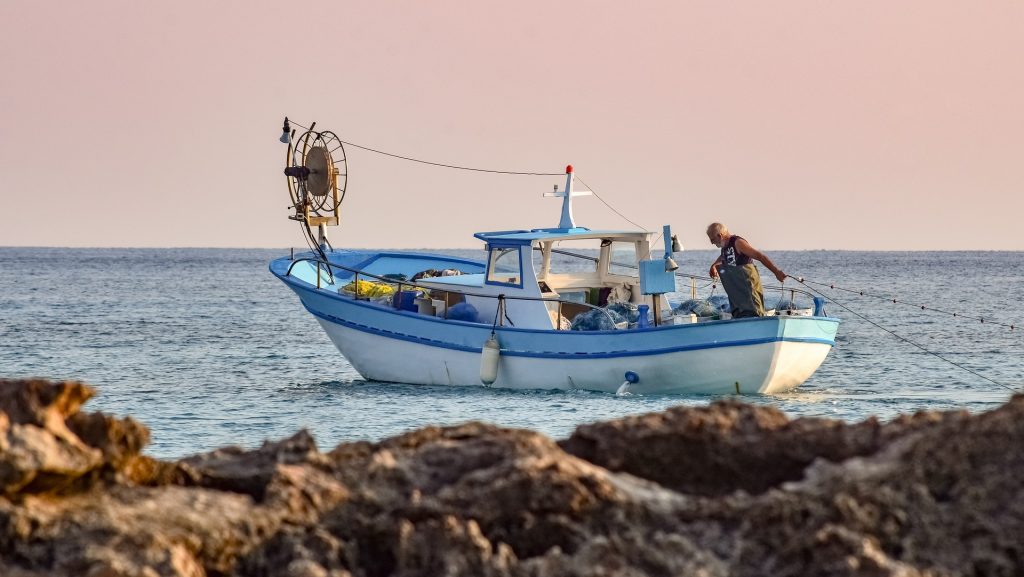When mackerel comes into mind, perhaps the first thing that enters into your thought is the delicious meat of this fish. This migratory species is known to travel through the Northern Gulf of Mexico during the spring season. They often return to South Florida towards the Western Gulf during the fall season.
So, if you are aiming to catch the Spanish Mackerel as part of your fishing goals, you would need to understand the fish better before deciding what best bait for Spanish Mackerel would fit your fishing adventure.
What Makes Spanish Mackerel Special?
The appearance of the Spanish mackerel represents a green back. The sides of this fish have silvery marks that have three rows of elliptical spots that are often colored with a shade between yellow, orange, and slight green. The color of each type of Spanish Mackerel is usually influenced by the location where they are thriving.
The teeth of Spanish Mackerels are flat, usually have a 64 count for a complete set of teeth. They are uniform in size and are flattened from every side.
The average mackerel grows from 36 to 37 inches in length and may weigh up to 14 pounds.

Where can you find the Spanish Mackerel?
As mentioned earlier, Spanish Mackerels are migratory fishes. They travel long and far across the seasons each year.
This means that if you plan to add the Spanish Mackerel into the list of fishes you want to catch as part of your game, you need to be prepared to learn more and research on where this type of fish could be found depending on the season when you want to make your journey.
Among the areas where the Mackerel consistently dwell include the Yucatan Peninsula, Cape Cod, and Massachusetts. Others can also be found along the shores of the Gulf of Mexico.
To understand better, it is best to understand the migration behavior of the Spanish Mackerel to know where to follow them, when.
Florida is often the destination of Spanish Mackerel that migrate from the Atlantic and the Gulf of Mexico.
As the temperature rises, the group of Spanish mackerel from the Atlantic begins to travel along the Atlantic Coast within US territories. From February to July, they travel through Miami, Florida until they reach Cape Cod, Massachusetts.
As the fall season begins, the Spanish Mackerel ravels back to Florida through the Eastern Gulf.
During winter and spring, the Spanish Mackerel finds shelter with the central west coast within Florida. As the season continues this type of fish continues to move towards a westward direction. The direction of the journey often terminates once they reach the northern coast of Texas.
Understanding the migration pattern of Spanish Mackerel gives fishers a chance to follow through where they might be able to catch Spanish mackerel by mass. This, however, may be a concern for commercial fishers. However, for those who just fish for recreation and leisure, the concern might be more on how to catch this fish using the best bait for the Spanish Mackerel.
If you are more about fishing as a game, you ought to understand the eating habit and the general culture of the Spanish Mackerel to be able to find the best bait for this fish depending on where it is currently thriving and how they react to these baits depending on the temperature of the water and everything else that is related to finding a better way of catching one as your reward.
What Does the Spanish Mackerel Eat?
Spanish Mackerel have known carnivores. Among the species that this fish feed on include shrimp and squid. Other options of feeds include anchovies as well as herring.
Depending on the location where they are thriving or are currently traveling through, the food preferences of the Spanish Mackerel also change. For instance, herring and menhaden clupeoids are often the preference of the groups of Spanish Mackerels thriving within Florida and Texas. The same thing could be said of those living in North Carolina and Veracruz.
Younger Spanish Mackerels are faster and are more agile than the older ones and thus they prefer anchovies compared to other species that they are now to feed off from.
Catching Spanish Mackerels either for commercial or leisure purposes continues to be at a great height. Up to these current years, Spanish Mackerels continue to attract the attention of both commercial and leisure fishers.
As observed through history, recreational fishers often troll and drift through boats to seek a possible vision of Spanish Mackerels. This is often done by casting spoons into the water and setting jigs to set up the lure for the targeted fish. Live-baits and lure retrievers are used to increase the efficiency of catching the Spanish Mackerel for leisure purposes.
On the other hand, the commercial method of harvesting Spanish Mackerel includes the use of gill netting.
Due to massive commercial fishing activity, there was a time when this type of fish became endangered as its rates of population plummet down. This is why beginning in 1987, the restructuring of the management of the Spanish Mackerel has been pursued to make sure that this group of fish would be able to thrive continuously through protective laws that keep the harvesting of the Spanish Mackerel at a limit.
Although the policies pursued to protect the population rate of Mackerel are not as tight as that of other protected species living within the locations where most Spanish Mackerels are thriving in and traveling through.

Let’s Get Serious in finding the Best Bait for Spanish Mackerel
To understand the type of bait to use to successfully catch Spanish Mackerel for anglers and leisure fishing enthusiasts, it must be understood that they respond differently to the baits depending on the location where they are currently thriving. As mentioned earlier, their attitude towards the food that they eat depends on the environment that surrounds them which largely involves the water temperature.
So to determine the best bait for Spanish Mackerel fishing, this part of the discussion shall determine where the fish is found and to what bait they may likely respond to at the moment.
FIRST: When in Florida
Based on the experience of professional anglers who often visit Florida to catch Spanish Mackerel thriving in the area, using a ¼ or ¾ ounce of silver spoon is effective in getting the attention of a school of Spanish Mackerel.
Because of the strength of pull of the Spanish Mackerel, it is suggested that using a braided line is most effective in reeling in the fish fast. With the use of a 30-pound leader, cut-offs could be avoided successfully.
Spanish Mackerel comes around when the temperature in the water reaches 70 degrees and above. The warm waters allow them to move faster up and down and gives them that freedom of motion. They are extremely athletic which pushes them to fund a consistent source of excitement especially when it comes to keeping up with the physical condition they need to have especially as they migrate through the seasons.
For this reason, catching Spanish Mackerel for game fishing is certainly challenging.
These groups of fish are known for their strength and their capacity to break rods. Given these conditions, make sure you have a strong rod before you make that journey towards catching a Spanish Mackerel for your rewards. From the tiptop to the rod to the line to the bait; everything should be strong enough to be able to tackle this fish successfully and finally reel it in.
TWO: When in the Surf
The beach is the destination you might want to consider visiting if you want to catch Spanish Mackerel during the months of the Spring to Summer season. So how do you know where they are on the beach?
Look for the birds. Birds, like anglers, love the challenge of catching the fast and agile Spanish Mackerel. So, where the birds are, it sure, the Spanish Mackerel are also present. When surfing off of the beach it is best to use anchovies and small sardines as best bait for Spanish Mackerel.
Be prepared; Spanish Mackerel that are found on the beach reach up to 12 pounds. They are large and heavy, so be ready to tackle with your catch.
What if there are no birds around? It is not always that there would bird around catching their meal from a group of Spanish Mackerel in the ocean. This is why you need to be prepared when you decide to fish within the surf. Bring longer fishing rods. Take note though that often, as the rod extends, it becomes much less flexible and is more prone to breaking. When catching Spanish Mackerel, you need to make sure that your fishing rod will not easily break. Investing in a high-quality fishing rod would certainly make your fishing adventure more satisfying.
Take note that Spanish Mackerel responds to small baits. Hence, minnow jogs may work as great baits to capture this fish. And to avoid the breakage of fishing rods, slow reel strategies are often applied.
THREE: Trolling for Spanish Mackerel
Using a small silver spoon is effective in hunting for schools of Spanish Mackerel. This strategy has been proven effective in covering larger scales of water which makes it easier to get the attention of the target fish.
When trolling, it is critical to take your time. If you are too fast, the fish will just draw themselves away from your distance.
Be subtle. Try as much as you can to not disturb the natural habitat of the Spanish Mackerel as you troll. Let the silver spoon create a natural feel of light refraction in the water which immediately gets the attention of the target fish.
FOUR: Catching Spanish Mackerels from Grass Flats
When in Grass Flats, Spanish Mackerels often settle in deeper parts.
Using light tackle and a good strategy of reaching a large school of Spanish Mackerel, you will surely be able to experience that great form of satisfaction from the excitement that comes from being able to catch this strong and agile fish.
Through the grass flats, remember that Spanish Mackerels are always in search of a wider surface of the water to be able to move with freedom. This type of fish does not follow through structure well. Hence, even though you are treading through grass flats, you need to find open grounds where they might likely be swimming.
Specific Best Bait for Spanish Mackerel
Gauging from history and response from Spanish Mackerels, here are four of the most effective baits that work best for anglers who target Spanish Mackerel as their game catches.
Before the four best bait for Spanish Mackerel is introduced, unlike when catching other large fish, this particular type of fish responds better to smaller baits. Anglers have particularly found smaller baits to be more effective because they can bite fully through these baits making it easier to have them stick to the line up to the time they are to be reeled up.
FIRST: Silver Spoons
Although silver spoons are generally used as the best bait for all different fishes it is considered one of the best baits for Spanish Mackerel because it is practically attractive and the fish respond immediately to this bait because of its natural lifelike behavior in the water.
A silver spoon naturally wiggles and wobbles around naturally as it touches the water and goes deeper. This motion uses both light and water to create a form of attraction among fishes. As you throw your silver spoon into the water, it is likely that a lot of fishes that will be interested in following it. Nonetheless, if there are Spanish Mackerels in the area, it is more likely that they will approach the silver spoon faster as they are more agile and stronger than other species.
Depending on the area where you are using the silver spoon as bait to catch the Silver Mackerel, it is best to reel in fast once you are sure that the fish has already followed through your bait and have a strong bite into your bait. Reeling the line in fast will not give the Spanish Mackerel to disengage with the bait that it has already bitten.
SECOND: Minnow Feather Jigs
This type of jig has an elongated head. It looks more like half a cigarette with a filter at the end. This bait can lure the Spanish Mackerel by simply dropping it where you assume the target fish is located. Once the fish bites, let it fall back even deeper to make sure that the fish assures its bite to the bait. Once you feel a harder pull downward, that means the bite of the fish is secured and it is now safe to immediately reel in the line to make your catch.
THIRD: Gotcha Lures
Gotcha lures look like anchovies once they hit the water. Usually, it is colored silver which is designed to attract light into the water as it sinks in deeper which is expected to immediately catch the attention of the Spanish Mackerel.
The treble hooks of this particular lure hang off the bottom. These are designed to provide a tougher makeup to your bait making it harder for the strong and agile Spanish Mackerel to break it easily.
Make sure that as you lower your bait, you target a school of Spanish mackerels to at least pick one of those that will bit into your bait. Like on the previous baits, naturally let it fall in deeper until you feel a tug on the line. Once you feel that the tug is strong enough- signaling that a Spanish Mackerel is already biting into it, it is best to reel in the line fast to bot lose your catch.
FOURTH: DOA CAL or Shad
Looking like life sardine or herring, the DOA CAL is a type of bait that often has a stronger capacity to hold on to the bite of the Spanish Mackerel once it makes the connection. However, it cannot be denied that because of its make, if the fish bites into it with the wrong impact, DOA CAL often breaks in half. So when using this as your bait to catch a Spanish Mackerel, you need to bring a whole buck to make sure you can continue with fishing without being disrupted because you have already run out of bait.
Key Takeaways
Finding the best bait for Spanish Mackerel is critical to making your fishing adventure to catch a strong and agile fish such as a mackerel to be both successful and satisfying.
The four primary baits noted in this post present the practicality of knowing the environment where the Spanish Mackerel is currently thriving to make sure that they would respond accordingly to the bait that you use.
In all these, there is nothing much better than knowing more about your target fish and researching better not only on the best bait for Spanish Mackerel but also on the most effective strategies used by experienced anglers to catch the target fish faster with the use of a more efficient process.


